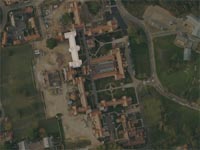







|
The design of the wards was largely uniform across the asylum with little differentiation for class of patient.
As was typical for a building of the corridor planform, a ward comprised of a single central gallery with a single bay window
along one side (these spaces doubled up as dormitories on first floors), day and dining rooms appended to either end, with single
rooms, stores and attendant rooms along the opposing side.
Lavatories and bathrooms were also associated with each ward but these were not housed in separate sanitation towers (as this was a
later construct and didnít start appearing until the 1860s and 1870s).
A contemporary description further underlined the identical design of the wards: "Each gallery contains two rooms for attendants,
so arranged as to overlook the dormitories, a store room, scullery, bath room and lavatory, all well fitted, and a supply of hot
and cold water is available at all times, night and day. Convenient to the wards are two large rooms, one on the male, the other
on the female side, used as dining rooms for the attendants, also a large amusement room."
One notable feature of the interiors of some of the wards was the curious curved ceilings with "honeycombed" textures. This was
Victorian fire-proofing (not sound dampening as some have guessed): it wasnít a popular feature (probably being expensive and time
consuming to build) and was only used at the Second Middlesex County Asylum (Colney Hatch, 1851), the First Essex County Asylum (Warley,1853) and
the First Lincoln County Asylum (St Johnís, 1852). |
 Ward #2 was located due north of the hall/chapel. Its main corridor faced due west over a large airing court. The photography of this ward was marked by stunning contrasts; many shots were taken twice as the sun often broke out behind the low clouds and offered an idealised view of the ward which the original architects desired and tried to enhance with the wardís orientation. Light streamed through the day room window, illuminating an otherwise empty room.
|

|

|

|

|

|

|

|

|

|
 Return to: Warley Hospital Return to: Warley Hospital
|